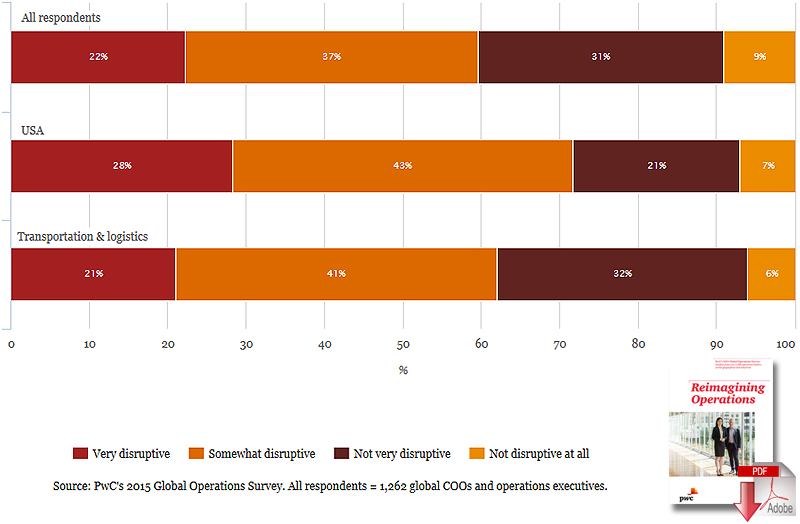Strategic Alignment in an Age of Digital Change

Operational excellence, particularly in the areas of technological adoption and cost realignment, will be central to the goal of executing through disruption.
Operational Excellence
The world was a turbulent place in 2015, and the powerful forces challenging and transforming industries across the globe are on track to continue in the year ahead.
Macroeconomic headwinds abroad and a strengthening US Dollar have combined with rapid technological evolution and changing customer preferences to bring about a period of tremendous competitive realignment for businesses.
Today, it is critical that companies go beyond making adjustments and instead open themselves up to a complete re-imagination of their strategic and operational purpose, including objectively assessing the competitive position and thoroughly realigning operations to the new normal.
Of course, this means different things for different businesses. Where one business might reap value from a refocused growth model centered on optimizing R&D investments, another may be better served by renovating its customer interface through the application of technology.
The unifying characteristic within each of these examples is the need to realign the operations of the business to underpin the initiative from strategy through execution.
The crucible created by current conditions heightens the need for companies to pursue operational excellence in any strategy, as even the most visionary strategies fail where execution falls short. And speed counts!
For our recently released Global Operations Survey, we spoke with over 1,200 operations leaders representing companies from a myriad of distinct industries and geographies.
We found these executives to be very much alive to the reality that success in operations today means more than maintaining an efficient and reliable supply chain. Many functions are becoming more focused on operations excellence to reduce cost and build capability muscle.
There is a broad-based push within these organizations to more deeply align their costs with their business strategy and more closely integrate various functional divisions of the organization in pursuit of common goals.
In that context, we see a few key areas that should be central to corporate efforts during 2016.
- Cash-rich companies, particularly in the tech sector, will continue to invest aggressively in R&D and turn more often to M&A to drive growth and innovation. Success will be driven by finding ways to use R&D to provide genuine customer value as well as to innovate and react to disruptive forces without interrupting the customer experience. Effective integration of newly developed or acquired capabilities into the organization’s operational framework is critical to driving value.
- Many companies will make delivery of more customer value a priority. By understanding and changing to meet customer needs, companies can dive deeper into how customers interact with them, not just how they use a product or service. This is forcing multiple functions within a business to work together to provide a seamless experience.
- Digital technology will become increasingly integral to companies across broad swaths of industry. The line between technology companies and technology-enabled companies competing within traditional industries has blurred, which will force organizations in every facet of the economy to realign their operations to compete in a digital world. Great digital customer experiences are high-visibility, and customers are actively demanding improved digital tools for all of their needs. When done right, digital can bring businesses closer to their customers. Executives should pay attention not only to how they can put digital tools to work but also to how the resulting customer interactions can be optimized through integration with the organization’s full suite of functional departments on the back end. Operational frameworks must be restructured to leverage the power of the new technology, both with respect to customer interface and internal operating processes, in order to remain competitive.
- Last but not least, the challenges of current macroeconomic conditions put a tremendous premium on maximizing the efficiency and reliability of corporate operations. Diamonds are created by time and pressure. Likewise, the companies that succeed in reforming themselves operationally to meet today’s multifaceted challenges will find themselves to have created enduring value and competitive strength. Companies will be well served by implementing operating strategies and procedures that underpin both a superior customer experience as well as seamless execution across all facets of an organization.
2016 is sure to be a year of transformation, and we see significant opportunities for executives to position themselves for success through the proactive renovation of the operational processes.
This ongoing period of disruption, though on the face it may seem simply turbulent, can be seized as an opportunity to build stronger more profitable companies.
Operational excellence, particularly in the areas of technological adoption and cost realignment, will be central to the goal of executing through disruption.
How disruptive do operations leaders think the following trends will be in the next five years?
In an interview with Logistics Management, Rodger Howell said that logistics managers will be expected to learn new tech skills to adapt to a digitized economy.
“There is a need for everyone to adapt to the ‘new normal,’” he said. “Many logistics managers deal with global distribution, which causes complex logistics flows, tax and duty compliance obligations. It is important that those in logistics consider a model that ensures efficient paths to market, while complying with the appropriate regulations and tax regimes.”
Embracing digitization is the best way to handle complexity and speed in operations, Howell noted.
“In addition, they need to be able to connect digitally to partners and customers in order to align cost with business strategy and cycle time out of those transactions.”
Statement: “Changes in core technologies”

Article Topics
PwC News & Resources
Ranking the Best Countries for Private Business in EMEA Tech Expectations Are Not Matching Reality For Many Companies Drone Technology: Clarity from Above Supply Chain Strategies under the Impact of COVID-19 of Large American Companies Operating in China Supply Chain: Your Brexit Competitive Advantage Digitization and Autonomous Driving to Halve Logistics Costs by 2030, finds PwC Study The Era of Digitized Trucking: Charting Your Transformation to a New Business Model More PwCLatest in Supply Chain
UPS Struggles in First Quarter With Steep Earnings Decline How Supply Chains Are Solving Severe Workplace Shortages SAP Unveils New AI-Driven Supply Chain Innovations How Much Extra Will Consumers Pay for Sustainable Packaging? FedEx Announces Plans to Shut Down Four Facilities U.S. Manufacturing is Growing but Employment Not Keeping Pace The Two Most Important Factors in Last-Mile Delivery More Supply Chain














